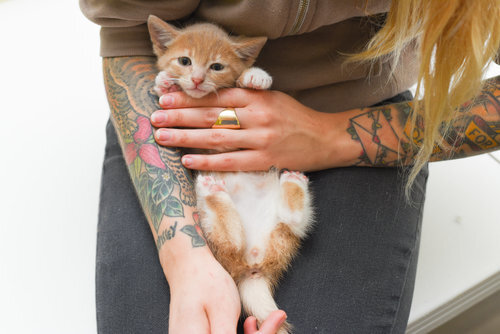Caring for Blind Kittens
If you're considering fostering or adopting a blind kitten, be assured that they can and do live happy, healthy lives. Blind kittens are every bit as playful, curious, rambunctious, loving, and cuddly as any other kitten—but there are things we can do to ensure that they are safe and thriving in our care.
Watch my instructional video here:
Understand the Kitten’s Health
Kittens can be born with or develop blindness for a number of reasons. Neurological conditions, congenital conditions, trauma, exposure to toxic compounds, and infection may all lead to partial or total loss of vision. If you suspect that a kitten is visually impaired, schedule an appointment with a veterinarian who can help to diagnose your kitten and offer advice.
If a kitten’s eyes are infected, read my article on helping kittens with eye infections, and seek medical attention from a veterinarian right away.
Set up a Safe Space
When you’re fostering or first introducing a blind kitten into your home, you’ll want to give them at least two weeks in a contained area like a playpen or guest room. Do not introduce them to the full house right away; keep them safely housed in one area to start. In their area:
Place a shallow litter box in the corner
Place food and water in an opposite corner
Give the kitten a soft bed or two
Choose safe enrichment items like ball chasers and ball tracks, low scratchers, and climbers or perches that are less than two feet in height.
Line the floor with large plush blankets or carpet pads, especially in areas where the kitten could fall from elevation higher than 6 inches
Plan to keep the space laid out in the same way so that the kitten can map it out and successfully navigate.
Always avoid hazards like access to the outdoors, bathtubs, fireplaces, sharp objects, reclining furniture, tall cat trees, or anywhere where they can fall or become stuck.
Help the Kitten Navigate the Space
Introducing a blind kitten to their surroundings involves gentle guidance. Initially, place them in the litter box several times to help them establish its location. Place them in front of their water and guide them by running your finger through it to help them hear where it is. For food, place them in front of it and establish an auditory cue for mealtime, such as a special whistle or even just the sound of the can opening. Keep the placement of these important items consistent, and they’ll have no trouble finding their litter, food and water!
Supervise their exploration of the environment by placing them near or on objects, ensuring a gradual introduction to climbing as they grow.
Most importantly: keep the environment consistent, as changes may disorient them. You’ll find that the kitten will gradually master the space, and once they do, you can slowly introduce them to more areas with supervision.
Choose Toys that Make Noise
Blind kittens are just as playful as their sighted counterparts, and choosing the right toys enhances their experience. Opt for interactive toys with audible components, such as:
When you engage in interactive play with a kitten who is blind, they can track the toy through hearing—and you’ll find they’re very capable little hunters! Like with any kitten, interactive playtime will promote their physical and mental well-being, and strengthen the bond between you and the kitten.
Establish Love and Trust
Spending quality time together is important when fostering or adopting any kitten. When working with a blind kitten, you’ll want to spend lots of time laying or sitting on the floor with them, letting them climb you and offering gentle petting.
Communication is key, and you can teach them auditory cues such as rubbing your fingers together to signal where your hand is for pets. Notice what works best for the kitten, whether that’s vocal or hand cues, and teach them to understand where you are and when you’re offering them affection. Never scold the kitten if they bite—this is common for any kitten, but especially for a kitten who is navigating their world without sight. Follow my advice for reducing biting behavior in kittens and you’ll be good to go!
Look for an Adopter Who Can Meet Their Needs
Most adopters won’t have experience with blind kittens, and that’s okay. What matters most is finding an adopter who is willing to learn and adapt their space for the kitten’s needs.
Ideally, look for an indoor home with a single level; if there are multiple floors, they’ll need to take additional precautions to prevent falls. Educate the potential adopter about potential hazards, and encourage gradual introduction to the home, starting with one safe room and eventually introducing new areas of the house with careful supervision.
In time, blind kittens can learn to fully navigate their living space—but it’s important that adopters understand not to rearrange furniture or introduce new large items without carefully reintroducing the kitten to the space!
If you’re considering adopting a blind kitten, watch my video about life with blind cats!
You’ve Got This
Thank you for helping blind kittens thrive! Fostering a blind kitten is such a fulfilling experience, and I hope you’re feeling confident and ready for the task. Blind cats adapt remarkably well—and with you giving them the right head start, they’re sure to lead happy lives!




